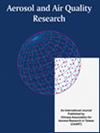Continuous Improvements and Future Challenges of Air Pollution Control at an Advanced Semiconductor Fab
IF 2.5
4区 环境科学与生态学
Q3 ENVIRONMENTAL SCIENCES
引用次数: 1
Abstract
This study reviews the air pollution control strategy at an advanced semiconductor fab focusing on its continuous improvements and future challenges. A wide range of air pollutants is emitted from various sources classified as organic solvents, corrosive, toxic and combustible gases. This effective strategy employs a two-stage treatment method to comply with national emission regulations. Eight different types of local scrubbers (typ. gas flow rate: 0.3–2.0 CMM for the dry type or 60–83.3 CMM for the wet type) are used as pre-treatment devices at the first stage to remove specific target pollutants with high concentrations emitted from process chambers. Exhaust gases from local scrubbers are then grouped and further treated by central control facilities at the second stage, including the dual zeolite rotor-concentrator plus the thermal oxidizer for VOCs (typ. gas flow rate: 2500 CMM), the dual-central wet scrubbers (CWS) and alkaline CWS (typ. gas flow rate: 2000 CMM) for acid and alkaline gases, respectively. After the two-stage treatment, the removal efficiency of the VOCs can reach higher than 98.4%, surpassing the emission standard of 90%. The design parameters and operating conditions of the CWSs meet the criteria set in the emission standard for the semiconductor industry. In the future, CWS performance can further be improved by using advanced structured packing materials with larger specific surface areas to shorten the residence time and lower the chemical dosing amount and pressure drop while achieving higher removal efficiency for acid and alkaline gases at a reduced operating cost. The challenges to removing derived fine PM and white smoke still remain which can be resolved by using efficient control devices in the pre-and post-treatment stages, such as wet electrostatic precipitators. Finally, the by-product NO x can be minimized by using low-NO x burners or de-NO x control technologies in the future.先进半导体工厂空气污染控制的持续改进和未来挑战
本研究回顾了先进半导体工厂的空气污染控制策略,重点是其持续改进和未来的挑战。各种各样的空气污染物从各种来源排放,分类为有机溶剂,腐蚀性,有毒和可燃气体。这种有效的策略采用两阶段处理方法,以符合国家排放法规。八种不同类型的本地洗涤器(类型。气体流速:干式为0.3-2.0 CMM,湿式为60-83.3 CMM)作为第一阶段的预处理装置,用于去除工艺室排放的高浓度特定目标污染物。然后,从本地洗涤塔排出的废气被分组,并在第二阶段由中央控制设施进一步处理,包括双沸石转子浓缩器和用于挥发性有机化合物(类型)的热氧化剂。气体流量:2500 CMM),双中心湿式洗涤器(CWS)和碱性CWS(型)。气体流量:2000 CMM),分别用于酸性和碱性气体。经过两级处理后,VOCs的去除率可达98.4%以上,超过了90%的排放标准。CWSs的设计参数和工作条件均符合半导体工业的发射标准。未来,可以通过采用更大比表面积的先进结构化填料来进一步提高水煤浆的性能,缩短停留时间,降低化学投加量和压降,同时以更低的运行成本实现对酸碱气体更高的去除效率。去除衍生细颗粒物和白烟的挑战仍然存在,这可以通过在处理前和处理后阶段使用有效的控制设备来解决,例如湿式静电除尘器。最后,在未来可以通过使用低nox燃烧器或去nox控制技术来减少副产物nox。
本文章由计算机程序翻译,如有差异,请以英文原文为准。
求助全文
约1分钟内获得全文
求助全文
来源期刊

Aerosol and Air Quality Research
ENVIRONMENTAL SCIENCES-
CiteScore
8.30
自引率
10.00%
发文量
163
审稿时长
3 months
期刊介绍:
The international journal of Aerosol and Air Quality Research (AAQR) covers all aspects of aerosol science and technology, atmospheric science and air quality related issues. It encompasses a multi-disciplinary field, including:
- Aerosol, air quality, atmospheric chemistry and global change;
- Air toxics (hazardous air pollutants (HAPs), persistent organic pollutants (POPs)) - Sources, control, transport and fate, human exposure;
- Nanoparticle and nanotechnology;
- Sources, combustion, thermal decomposition, emission, properties, behavior, formation, transport, deposition, measurement and analysis;
- Effects on the environments;
- Air quality and human health;
- Bioaerosols;
- Indoor air quality;
- Energy and air pollution;
- Pollution control technologies;
- Invention and improvement of sampling instruments and technologies;
- Optical/radiative properties and remote sensing;
- Carbon dioxide emission, capture, storage and utilization; novel methods for the reduction of carbon dioxide emission;
- Other topics related to aerosol and air quality.
 求助内容:
求助内容: 应助结果提醒方式:
应助结果提醒方式:


